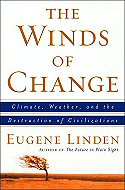The Winds of Change: Climate, Weather, and
the Destruction of Civilizations
|
|
Eugene Linden
|

|

From the preface
[...] I offer evidence that we disregard the role of climate in history at our peril. I've structured the book along the lines of a case. The opening section presents the prosecution's argument that climate change has either killed off or at least been an accomplice in the fall of several civilizations. It quickly runs through the various victims (and a notable evolutionary beneficiary), and also details the weapons and methods of this civilizations killer.
The first chapter of Part Two explores how environmental factors, including climate, have fallen in and out of favor as force affecting history. Subsequent chapters in this section offer a brief description of the gears of our climate system and then look into the forensics of climate history, describing and assessing the various proxies that paleoclimatologists use to reconstruct past weather. The section also suggests some big unanswered questions about past climate and how climate works, questions that have a bearing on our assessment of the present threat of climate change.
Part Three revisits the cases introduced in the opening section; it presents dissenting opinions and digs deeper into the implications of the proxy evidence. Part Four looks at El Nino as a force in history. Although that familiar event is not nearly as disruptive as other climate events of the more distant past, this regular cycle has had huge impacts on humanity at different times. Some historians argue that a series of El Ninos in the late nineteenth century killed more people than the two world wars of the twentieth century combined. Moreover, there is a detailed record of El Nino's role in various historical events that reveals both the resiliency of the modern market economy as well as new vulnerabilities to changing climate.
In Part Five, we return to the present. The first chapter looks in detail at the particularities of the climate-change story as it has unfolded since the threat first surfaced. In the next chapter, I join a research expedition in the Gulf Stream to check the health of one of the vital organs of the global climate system. The final section draws on what happened in the past and what is happening in the present to develop a scenario of what we may face in the future.
We have an advantage over past civilizations that were blindsided by climate change. We can learn from their misfortunes.
|
|
